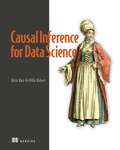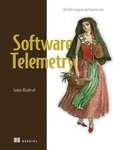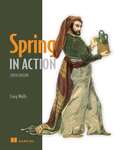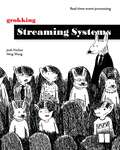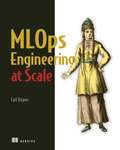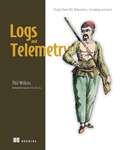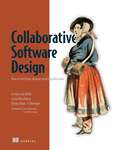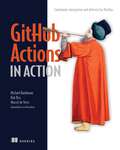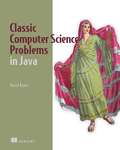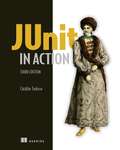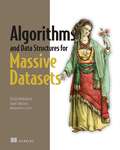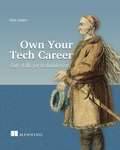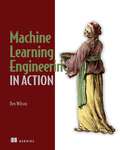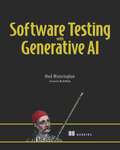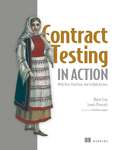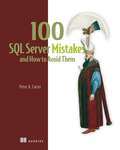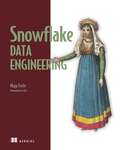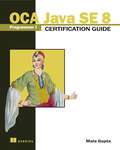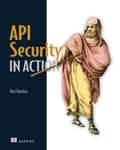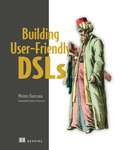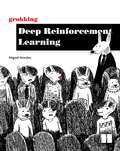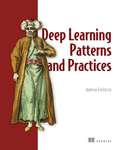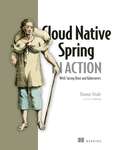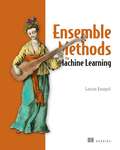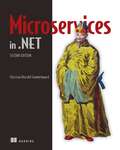- Table View
- List View
Causal Inference for Data Science
by Aleix Ruiz de Villa RobertWhen you know the cause of an event, you can affect its outcome. This accessible introduction to causal inference shows you how to determine causality and estimate effects using statistics and machine learning.A/B tests or randomized controlled trials are expensive and often unfeasible in a business environment. Causal Inference for Data Science reveals the techniques and methodologies you can use to identify causes from data, even when no experiment or test has been performed. In Causal Inference for Data Science you will learn how to: • Model reality using causal graphs • Estimate causal effects using statistical and machine learning techniques • Determine when to use A/B tests, causal inference, and machine learning • Explain and assess objectives, assumptions, risks, and limitations • Determine if you have enough variables for your analysis It&’s possible to predict events without knowing what causes them. Understanding causality allows you both to make data-driven predictions and also intervene to affect the outcomes. Causal Inference for Data Science shows you how to build data science tools that can identify the root cause of trends and events. You&’ll learn how to interpret historical data, understand customer behaviors, and empower management to apply optimal decisions. About the technology Why did you get a particular result? What would have lead to a different outcome? These are the essential questions of causal inference. This powerful methodology improves your decisions by connecting cause and effect—even when you can&’t run experiments, A/B tests, or expensive controlled trials. About the book Causal Inference for Data Science introduces techniques to apply causal reasoning to ordinary business scenarios. And with this clearly-written, practical guide, you won&’t need advanced statistics or high-level math to put causal inference into practice! By applying a simple approach based on Directed Acyclic Graphs (DAGs), you&’ll learn to assess advertising performance, pick productive health treatments, deliver effective product pricing, and more. What's inside • When to use A/B tests, causal inference, and ML • Assess objectives, assumptions, risks, and limitations • Apply causal inference to real business data About the reader For data scientists, ML engineers, and statisticians. About the author Aleix Ruiz de Villa Robert is a data scientist with a PhD in mathematical analysis from the Universitat Autònoma de Barcelona. Table of Contents Part 1 1 Introducing causality 2 First steps: Working with confounders 3 Applying causal inference 4 How machine learning and causal inference can help each other Part 2 5 Finding comparable cases with propensity scores 6 Direct and indirect effects with linear models 7 Dealing with complex graphs 8 Advanced tools with the DoubleML library Part 3 9 Instrumental variables 10 Potential outcomes framework 11 The effect of a time-related event A The math behind the adjustment formula B Solutions to exercises in chapter 2 C Technical lemma for the propensity scores D Proof for doubly robust estimator E Technical lemma for the alternative instrumental variable estimator F Proof of the instrumental variable formula for imperfect compliance
Software Telemetry: Reliable logging and monitoring
by Jamie RiedeselSoftware Telemetry shows you how to efficiently collect, store, and analyze system and application log data so you can monitor and improve your systems. Summary In Software Telemetry you will learn how to: Manage toxic telemetry and confidential records Master multi-tenant techniques and transformation processes Update to improve the statistical validity of your metrics and dashboards Make software telemetry emissions easier to parse Build easily-auditable logging systems Prevent and handle accidental data leaks Maintain processes for legal compliance Justify increased spend on telemetry software Software Telemetry teaches you best practices for operating and updating telemetry systems. These vital systems trace, log, and monitor infrastructure by observing and analyzing the events generated by the system. This practical guide is filled with techniques you can apply to any size of organization, with troubleshooting techniques for every eventuality, and methods to ensure your compliance with standards like GDPR. About the technology Take advantage of the data generated by your IT infrastructure! Telemetry systems provide feedback on what&’s happening inside your data center and applications, so you can efficiently monitor, maintain, and audit them. This practical book guides you through instrumenting your systems, setting up centralized logging, doing distributed tracing, and other invaluable telemetry techniques. About the book Software Telemetry shows you how to efficiently collect, store, and analyze system and application log data so you can monitor and improve your systems. Manage the pillars of observability—logs, metrics, and traces—in an end-to-end telemetry system that integrates with your existing infrastructure. You&’ll discover how software telemetry benefits both small startups and legacy enterprises. And at a time when data audits are increasingly common, you&’ll appreciate the thorough coverage of legal compliance processes, so there&’s no reason to panic when a discovery request arrives. What's inside Multi-tenant techniques and transformation processes Toxic telemetry and confidential records Updates to improve the statistical validity of your metrics and dashboards Revisions that make software telemetry emissions easier to parse About the reader For software developers and infrastructure engineers supporting and building telemetry systems. About the author Jamie Riedesel is a staff engineer at Dropbox with over twenty years of experience in IT. Table of Contents 1 Introduction PART 1 TELEMETRY SYSTEM ARCHITECTURE 2 The Emitting stage: Creating and submitting telemetry 3 The Shipping stage: Moving and storing telemetry 4 The Shipping stage: Unifying diverse telemetry formats 5 The Presentation stage: Displaying telemetry 6 Marking up and enriching telemetry 7 Handling multitenancy PART 2 USE CASES REVISITED: APPLYING ARCHITECTURE CONCEPTS 8 Growing cloud-based startup 9 Nonsoftware business 10 Long-established business IT PART 3 TECHNIQUES FOR HANDLING TELEMETRY 11 Optimizing for regular expressions at scale 12 Standardized logging and event formats 13 Using more nonfile emitting techniques 14 Managing cardinality in telemetry 15 Ensuring telemetry integrity 16 Redacting and reprocessing telemetry 17 Building policies for telemetry retention and aggregation 18 Surviving legal processes
Spring in Action, Sixth Edition
by Craig WallsIf you need to learn Spring, look no further than this widely beloved and comprehensive guide! Fully revised for Spring 5.3, and packed with interesting real-world examples to get your hands dirty with Spring.In Spring in Action, 6th Edition you will learn: Building reactive applications Relational and NoSQL databases Integrating via HTTP and REST-based services, and sand reactive RSocket services Reactive programming techniques Deploying applications to traditional servers and containers Securing applications with Spring Security Over the years, Spring in Action has helped tens of thousands of developers get a major productivity boost from Spring. This new edition of the classic bestseller covers all of the new features of Spring 5.3 and Spring Boot 2.4 along with examples of reactive programming, Spring Security for REST Services, and bringing reactivity to your databases. You'll also find the latest Spring best practices, including Spring Boot for application setup and configuration. About the technology Spring is required knowledge for Java developers! Why? Th is powerful framework eliminates a lot of the tedious configuration and repetitive coding tasks, making it easy to build enterprise-ready, production-quality software. The latest updates bring huge productivity boosts to microservices, reactive development, and other modern application designs. It&’s no wonder over half of all Java developers use Spring. About the book Spring in Action, Sixth Edition is a comprehensive guide to Spring&’s core features, all explained in Craig Walls&’ famously clear style. You&’ll put Spring into action as you build a complete database-backed web app step-by-step. This new edition covers both Spring fundamentals and new features such as reactive flows, Kubernetes integration, and RSocket. Whether you&’re new to Spring or leveling up to Spring 5.3, make this classic bestseller your bible! What's inside Relational and NoSQL databases Integrating via RSocket and REST-based services Reactive programming techniques Deploying applications to traditional servers and containers About the reader For beginning to intermediate Java developers. About the author Craig Walls is an engineer at VMware, a member of the Spring engineering team, a popular author, and a frequent conference speaker. Table of Contents PART 1 FOUNDATIONAL SPRING 1 Getting started with Spring 2 Developing web applications 3 Working with data 4 Working with nonrelational data 5 Securing Spring 6 Working with configuration properties PART 2 INTEGRATED SPRING 7 Creating REST services 8 Securing REST 9 Sending messages asynchronously 10 Integrating Spring PART 3 REACTIVE SPRING 11 Introducing Reactor 12 Developing reactive APIs 13 Persisting data reactively 14 Working with RSocket PART 4 DEPLOYED SPRING 15 Working with Spring Boot Actuator 16 Administering Spring 17 Monitoring Spring with JMX 18 Deploying Spring
Grokking Streaming Systems: Real-time event processing
by Ning Wang Josh FischerA friendly, framework-agnostic tutorial that will help you grok how streaming systems work—and how to build your own!In Grokking Streaming Systems you will learn how to: Implement and troubleshoot streaming systems Design streaming systems for complex functionalities Assess parallelization requirements Spot networking bottlenecks and resolve back pressure Group data for high-performance systems Handle delayed events in real-time systems Grokking Streaming Systems is a simple guide to the complex concepts behind streaming systems. This friendly and framework-agnostic tutorial teaches you how to handle real-time events, and even design and build your own streaming job that&’s a perfect fit for your needs. Each new idea is carefully explained with diagrams, clear examples, and fun dialogue between perplexed personalities! About the technology Streaming systems minimize the time between receiving and processing event data, so they can deliver responses in real time. For applications in finance, security, and IoT where milliseconds matter, streaming systems are a requirement. And streaming is hot! Skills on platforms like Spark, Heron, and Kafka are in high demand. About the book Grokking Streaming Systems introduces real-time event streaming applications in clear, reader-friendly language. This engaging book illuminates core concepts like data parallelization, event windows, and backpressure without getting bogged down in framework-specific details. As you go, you&’ll build your own simple streaming tool from the ground up to make sure all the ideas and techniques stick. The helpful and entertaining illustrations make streaming systems come alive as you tackle relevant examples like real-time credit card fraud detection and monitoring IoT services. What's inside Implement and troubleshoot streaming systems Design streaming systems for complex functionalities Spot networking bottlenecks and resolve backpressure Group data for high-performance systems About the reader No prior experience with streaming systems is assumed. Examples in Java. About the author Josh Fischer and Ning Wang are Apache Committers, and part of the committee for the Apache Heron distributed stream processing engine. Table of Contents PART 1 GETTING STARTED WITH STREAMING 1 Welcome to Grokking Streaming Systems 2 Hello, streaming systems! 3 Parallelization and data grouping 4 Stream graph 5 Delivery semantics 6 Streaming systems review and a glimpse ahead PART 2 STEPPING UP 7 Windowed computations 8 Join operations 9 Backpressure 10 Stateful computation 11 Wrap-up: Advanced concepts in streaming systems
MLOps Engineering at Scale
by Carl OsipovDodge costly and time-consuming infrastructure tasks, and rapidly bring your machine learning models to production with MLOps and pre-built serverless tools!In MLOps Engineering at Scale you will learn: Extracting, transforming, and loading datasets Querying datasets with SQL Understanding automatic differentiation in PyTorch Deploying model training pipelines as a service endpoint Monitoring and managing your pipeline&’s life cycle Measuring performance improvements MLOps Engineering at Scale shows you how to put machine learning into production efficiently by using pre-built services from AWS and other cloud vendors. You&’ll learn how to rapidly create flexible and scalable machine learning systems without laboring over time-consuming operational tasks or taking on the costly overhead of physical hardware. Following a real-world use case for calculating taxi fares, you will engineer an MLOps pipeline for a PyTorch model using AWS server-less capabilities. About the technology A production-ready machine learning system includes efficient data pipelines, integrated monitoring, and means to scale up and down based on demand. Using cloud-based services to implement ML infrastructure reduces development time and lowers hosting costs. Serverless MLOps eliminates the need to build and maintain custom infrastructure, so you can concentrate on your data, models, and algorithms. About the book MLOps Engineering at Scale teaches you how to implement efficient machine learning systems using pre-built services from AWS and other cloud vendors. This easy-to-follow book guides you step-by-step as you set up your serverless ML infrastructure, even if you&’ve never used a cloud platform before. You&’ll also explore tools like PyTorch Lightning, Optuna, and MLFlow that make it easy to build pipelines and scale your deep learning models in production. What's inside Reduce or eliminate ML infrastructure management Learn state-of-the-art MLOps tools like PyTorch Lightning and MLFlow Deploy training pipelines as a service endpoint Monitor and manage your pipeline&’s life cycle Measure performance improvements About the reader Readers need to know Python, SQL, and the basics of machine learning. No cloud experience required. About the author Carl Osipov implemented his first neural net in 2000 and has worked on deep learning and machine learning at Google and IBM. Table of Contents PART 1 - MASTERING THE DATA SET 1 Introduction to serverless machine learning 2 Getting started with the data set 3 Exploring and preparing the data set 4 More exploratory data analysis and data preparation PART 2 - PYTORCH FOR SERVERLESS MACHINE LEARNING 5 Introducing PyTorch: Tensor basics 6 Core PyTorch: Autograd, optimizers, and utilities 7 Serverless machine learning at scale 8 Scaling out with distributed training PART 3 - SERVERLESS MACHINE LEARNING PIPELINE 9 Feature selection 10 Adopting PyTorch Lightning 11 Hyperparameter optimization 12 Machine learning pipeline
Logs and Telemetry: Using Fluent Bit, Kubernetes, streaming and more
by Phil WilkinsBuild cloud native observability pipelines with minimal footprints and high-performance throughput—all with Fluent Bit, Kubernetes, and your favorite visualization and analytics tools.Logs and Telemetry is an all-practical guide to monitoring both cloud-native and traditional environments with the Fluent Bit observability tool. It takes you from the basics of collecting app logs, all the way to filtering, routing, enriching and transforming logs, metrics, and traces. Inside Logs and Telemetry you&’ll learn how to: • Deploy Fluent Bit for telemetry (log, metric, and trace) collection • Configure pipelines to filter, route, and transform data • Integrate Fluent Bit with containers and Kubernetes • Configure Fluent Bit to work with OpenTelemetry, Prometheus, and other open source tech • Monitor applications at scale with minimal footprint • Address challenges in Kubernetes-based ecosystems using Fluent Bit • Utilize Fluent Bit for real-time event analytics to derive new metrics and insights • Develop custom filters, inputs, and outputs for unique or reusable use cases Logs and Telemetry draws on both the input and support of key committers and founders of Fluent Bit, and author Phil Wilkins&’ years of experience in DevOps. Inside, you&’ll see how you can integrate Fluent Bit with Prometheus, OpenTelemetry, FluentD deployments, and more. Learn how Fluent Bit can not only meet all the demands of cloud-native use cases, but also more traditional deployments as well. About the technology Fluent Bit is a super-fast lightweight observability tool that&’s perfect for Kubernetes and containers, as well as traditional IT environments. Fluent Bit makes it a snap to extract meaning from the logs, traces, and other performance metrics generated by your applications and infrastructure. It&’s also a great way to route telemetry to analysis tools like Prometheus and Grafana. About the book Logs and Telemetry shows you how to turn systems data into actionable insights using Fluent Bit. You&’ll start by learning the pre-built plugins for common use cases and progress to integration with powerful tools like OpenTelemetry and real-time analytical event processing. You&’ll use plugins to configure routing, filtering and processing, automate your observability with Lua scripts, and configure Fluent Bit to meet the demands of highly scalable environments. What's inside • Deploy Fluent Bit for telemetry collection • Configure pipelines to filter, route, and transform data • Integrate Fluent Bit with containers and Kubernetes • Monitor applications at scale About the reader For developers, DevOps engineers, and SREs working with observability. About the author Phil Wilkins has spent over 25 years in the software industry from multinationals to software startups. He is the author of Logging in Action. The technical editor on this book was Karthik Gaekwad. Table of Contents Part 1 1 Introduction to Fluent Bit 2 From zero to &“Hello, World&” Part 2 3 Capturing inputs 4 Getting inputs from containers and Kubernetes 5 Outputting events 6 Parsing to extract more meaning 7 Filtering and transforming events Part 3 8 Stream processors for time series calculations and filtering 9 Building processors and Fluent Bit extension options 10 Building plugins 11 Putting Fluent Bit into action: An enterprise use case Appendix A Installations Appendix B Useful resources Appendix C Comparing Fluent Bit and Fluentd
Collaborative Software Design: How to facilitate domain modeling decisions
by Evelyn van Kelle Gien Verschatse Kenny Baas-SchweglerEmerging practices, collaboration tools, and effective techniques for incorporating your key stakeholders into the software design process.Don&’t spend months building the wrong software! Collaborative Software Design is a unique and practical guide for effectively involving all stakeholders in the design of software to ensure sustainable design decisions. In Collaborative Software Design you&’ll learn how to: • Prepare and facilitate collaborative modeling sessions with tools such as Business Model Canvas, Event Storming, Domain Storytelling, Example Mapping, and Wardley Mapping • Pick and apply heuristics for modeling software design • Techniques for getting all needed knowledge from the group • The influence of ranking • The impact and opportunities of cognitive bias • Resistance and conflict resolution • Practices for following up after a modeling session • Document the session and report to stakeholders Collaborative Software Design combines its authors&’ deep experience in behavioral science, decision-making theory and software architecture into an essential guide for making collaborative design decisions. You&’ll learn to use process visualizations, engaging sessions, and social dynamic management to ensure every stakeholder is contributing their vital insights to a project. Best of all, the skills you&’ll learn make it easy for software teams to develop software directly with their stakeholders—no need to rely on a centralized or top-down design. Forewords by Diana Montalion and Trond Hjorteland. About the technology Delivering high-quality software requires the active participation of all stakeholders in the design process. But how do you align individuals with different roles, perspectives, and priorities to create sustainable software? Collaborative Software Design presents proven strategies that you can use to foster productive decision making, resolve conflicts and uncertainties, and elevate the quality of design outcomes. About the book In Collaborative Software Design, you&’ll explore principles, techniques, and tools to promote safe communication as you discover business problems, formalize requirements, and implement a software project. It highlights established collaborative modeling tools like Event Storming, Example Mapping, Wardley Mapping, and Domain Storytelling, and introduces unique approaches for managing cognitive biases, conflict, and organizational hierarchy. Whether you&’re a business stakeholder, a technical contributor, or a professional facilitator, you&’ll learn how to hear and benefit from every voice in the room. What's inside • Prepare and lead collaborative modeling sessions • Turn conflict into innovation • Make sustainable software design decisions • Improve software design from a sociotechnical perspective About the reader For anyone involved in the software development process. About the author Evelyn van Kelle, Gien Verschatse, and Kenny Baas-Schwegler are internationally recognized experts in collaborative modeling and organizational decision making for sociotechnical systems. The technical editor on this book was Charlie Schafer.
GitHub Actions in Action: Continuous integration and delivery for DevOps
by Michael KaufmannAutomate your build, test, and deploy pipelines using GitHub Actions!Continuous delivery (CI/CD) pipelines help you automate the software development process and maximize your team&’s efficiency. GitHub Actions in Action teaches you how to build, test, and deploy pipelines in GitHub Actions through hands-on labs and projects. In GitHub Actions in Action you will learn how to: • Create and share GitHub Actions workflows • Automate CI/CD workloads and other GitHub tasks • Secure release pipelines with secrets, variables, and environments • Support compliance frameworks • Create safe and scalable self-hosted runners Written by three Microsoft MVPs and tech reviewed by a Staff DevOps Architect from GitHub, this book delivers the hardworking skills and advice you&’ll need to be successful on the job. DevOps engineers will love GitHub Actions in Action&’s coverage of reliable methods for Infrastructure-as-Code and automating cloud environments. You&’ll follow an extended example application for selling tickets, taking it all the way from initial build to cloud deployment. Foreword by Scott Hanselman. About the technology Believe it or not, CI/CD can be simple! With GitHub Actions, you can automate your entire dev process using just the tools built into GitHub—no external frameworks or complex integrations required. GitHub Actions is secure, reliable, and best of all, easy. This book will get you started. About the book GitHub Actions in Action teaches you how to build automated delivery pipelines in GitHub. You&’ll start with simple examples that demonstrate workflow and action basics, and then you&’ll dive into platform architecture, security, and workflow runtime details. As you go, you&’ll build a full CI/CD pipeline, optimizing for compliance, performance, and costs. You&’ll even create shareable actions for the GitHub marketplace. What's inside • Create and share GitHub Actions workflows • Automate testing and other GitHub tasks • Secure release pipelines with secrets, variables, and environments About the reader For developers and DevOps engineers comfortable with GitHub. About the author Michael Kaufmann is a Microsoft Regional Director and MVP. Rob Bos is an Azure and GitHub Trainer, a Microsoft MVP, a GitHub Star, and a LinkedIn Learning Instructor. Marcel de Vries is a CTO of Xebia Microsoft Services, Microsoft Regional Director, and MVP. The technical editor on this book was James Michael Gousset. Table of Contents Part 1 1 Introduction to GitHub Actions 2 Hands-on: My first Actions workflow 3 Workflows 4 GitHub Actions Part 2 5 Runners 6 Self-hosted runners 7 Managing your self-hosted runners Part 3 8 Continuous integration 9 Continuous delivery 10 Security 11 Compliance 12 Improving workflow performance and costs
Classic Computer Science Problems in Java
by David KopecSharpen your coding skills by exploring established computer science problems! Classic Computer Science Problems in Java challenges you with time-tested scenarios and algorithms.Summary Sharpen your coding skills by exploring established computer science problems! Classic Computer Science Problems in Java challenges you with time-tested scenarios and algorithms. You&’ll work through a series of exercises based in computer science fundamentals that are designed to improve your software development abilities, improve your understanding of artificial intelligence, and even prepare you to ace an interview. As you work through examples in search, clustering, graphs, and more, you'll remember important things you've forgotten and discover classic solutions to your "new" problems! Purchase of the print book includes a free eBook in PDF, Kindle, and ePub formats from Manning Publications. About the technology Whatever software development problem you&’re facing, odds are someone has already uncovered a solution. This book collects the most useful solutions devised, guiding you through a variety of challenges and tried-and-true problem-solving techniques. The principles and algorithms presented here are guaranteed to save you countless hours in project after project. About the book Classic Computer Science Problems in Java is a master class in computer programming designed around 55 exercises that have been used in computer science classrooms for years. You&’ll work through hands-on examples as you explore core algorithms, constraint problems, AI applications, and much more. What's inside Recursion, memoization, and bit manipulation Search, graph, and genetic algorithms Constraint-satisfaction problems K-means clustering, neural networks, and adversarial search About the reader For intermediate Java programmers. About the author David Kopec is an assistant professor of Computer Science and Innovation at Champlain College in Burlington, Vermont. Table of Contents 1 Small problems 2 Search problems 3 Constraint-satisfaction problems 4 Graph problems 5 Genetic algorithms 6 K-means clustering 7 Fairly simple neural networks 8 Adversarial search 9 Miscellaneous problems 10 Interview with Brian Goetz
JUnit in Action
by Catalin TudoseJUnit in Action, Third Edition has been completely rewritten for this release. The book is full of examples that demonstrate JUnit's modern features, including its new architecture; nested, tagged, and dynamic tests; and dependency injection.Summary JUnit is the gold standard for unit testing Java applications. Filled with powerful new features designed to automate software testing, JUnit 5 boosts your productivity and helps avoid debugging nightmares. Whether you're just starting with JUnit or you want to ramp up on the new features, JUnit in Action, Third Edition has you covered. Extensively revised with new code and new chapters, JUnit in Action, Third Edition is an up-to-date guide to smooth software testing. Dozens of hands-on examples illustrate JUnit 5's innovations for dependency injection, nested testing, parameterized tests, and more. Throughout, you&’ll learn how to use JUnit 5 to automate your testing, for a process that consumes less resources, and gives you more time for developing. Purchase of the print book includes a free eBook in PDF, Kindle, and ePub formats from Manning Publications. About the technology The JUnit framework is the gold standard for unit testing Java applications—and knowing it is an essential skill for Java developers. The latest version, JUnit 5, is a total overhaul, now supporting modern Java features like Lambdas and Streams. About the book JUnit in Action, Third Edition has been completely rewritten for this release. The book is full of examples that demonstrate JUnit's modern features, including its new architecture; nested, tagged, and dynamic tests; and dependency injection. You'll benefit from author Catalin Tudose's unique "pyramid" testing strategy, which breaks the testing process into layers and sets you on the path to bug-free code creation. What's inside Migrating from JUnit 4 to 5 Effective test automation Test-driven development and behavior-driven development Using mocks for test isolation Connecting JUnit 5 with Maven or Gradle About the reader For intermediate Java developers. About the author Catalin Tudose has a Ph.D. in Computer Science, and over 15 years of experience as a Senior Java Developer and Technical Team Lead. Previous editions were authored by Petar Tahchiev, Felipe Leme, Gary Gregory, and Vincent Massol. Table of Contents PART 1 - JUNIT 1 JUnit jump-start 2 Exploring core JUnit 3 JUnit architecture 4 Migrating from JUnit 4 to JUnit 5 5 Software testing principles PART 2 - DIFFERENT TESTING STRATEGIES 6 Test quality 7 Coarse-grained testing with stubs 8 Testing with mock objects 9 In-container testing PART 3 - WORKING WITH JUNIT 5 AND OTHER TOOLS 10 Runing JUnit tests from Maven 3 11 Running JUnit tests from Gradle 6 12 JUnit 5 IDE support 13 Coninuous integration with JUnit 5 PART 4 - WORKING WITH MODERN FRAMEWORKS AND JUNIT 5 14 JUnit 5 extension model 15 Presentation-layer testing 16 Testing Spring applications 17 Testing Spring Boot applications 18 Testing a REST API 19 Testing database applications PART 5 - DEVELOPING APPLICATIONS WITH JUNIT 5 20 Test-driven development with JUnit 5 21 Behavior-driven development in JUnit 5 22 Implementing a test pyramid strategy with JUnit 5
Algorithms and Data Structures for Massive Datasets
by Dzejla Medjedovic Emin TahirovicMassive modern datasets make traditional data structures and algorithms grind to a halt. This fun and practical guide introduces cutting-edge techniques that can reliably handle even the largest distributed datasets.In Algorithms and Data Structures for Massive Datasets you will learn: Probabilistic sketching data structures for practical problems Choosing the right database engine for your application Evaluating and designing efficient on-disk data structures and algorithms Understanding the algorithmic trade-offs involved in massive-scale systems Deriving basic statistics from streaming data Correctly sampling streaming data Computing percentiles with limited space resources Algorithms and Data Structures for Massive Datasets reveals a toolbox of new methods that are perfect for handling modern big data applications. You&’ll explore the novel data structures and algorithms that underpin Google, Facebook, and other enterprise applications that work with truly massive amounts of data. These effective techniques can be applied to any discipline, from finance to text analysis. Graphics, illustrations, and hands-on industry examples make complex ideas practical to implement in your projects—and there&’s no mathematical proofs to puzzle over. Work through this one-of-a-kind guide, and you&’ll find the sweet spot of saving space without sacrificing your data&’s accuracy. About the technology Standard algorithms and data structures may become slow—or fail altogether—when applied to large distributed datasets. Choosing algorithms designed for big data saves time, increases accuracy, and reduces processing cost. This unique book distills cutting-edge research papers into practical techniques for sketching, streaming, and organizing massive datasets on-disk and in the cloud. About the book Algorithms and Data Structures for Massive Datasets introduces processing and analytics techniques for large distributed data. Packed with industry stories and entertaining illustrations, this friendly guide makes even complex concepts easy to understand. You&’ll explore real-world examples as you learn to map powerful algorithms like Bloom filters, Count-min sketch, HyperLogLog, and LSM-trees to your own use cases. What's inside Probabilistic sketching data structures Choosing the right database engine Designing efficient on-disk data structures and algorithms Algorithmic tradeoffs in massive-scale systems Computing percentiles with limited space resources About the reader Examples in Python, R, and pseudocode. About the author Dzejla Medjedovic earned her PhD in the Applied Algorithms Lab at Stony Brook University, New York. Emin Tahirovic earned his PhD in biostatistics from University of Pennsylvania. Illustrator Ines Dedovic earned her PhD at the Institute for Imaging and Computer Vision at RWTH Aachen University, Germany. Table of Contents 1 Introduction PART 1 HASH-BASED SKETCHES 2 Review of hash tables and modern hashing 3 Approximate membership: Bloom and quotient filters 4 Frequency estimation and count-min sketch 5 Cardinality estimation and HyperLogLog PART 2 REAL-TIME ANALYTICS 6 Streaming data: Bringing everything together 7 Sampling from data streams 8 Approximate quantiles on data streams PART 3 DATA STRUCTURES FOR DATABASES AND EXTERNAL MEMORY ALGORITHMS 9 Introducing the external memory model 10 Data structures for databases: B-trees, Bε-trees, and LSM-trees 11 External memory sorting
Own Your Tech Career: Soft skills for technologists
by Don JonesOwn Your Tech Career: Soft skills for technologists is a guide to taking control of your professional life. It teaches you to approach your career with planning and purpose, always making active decisions towards your goals.Summary In Own Your Tech Career: Soft skills for technologists, you will: Define what &“success&” means for your career Discover personal branding and career maintenance Prepare for and conduct a tech job hunt Spot speed bumps and barriers that can derail your progress Learn how to navigate the rules of the business world Perform market analysis to keep your tech skills fresh and relevant Whatever your road to success, you&’ll benefit from the toolbox of career-boosting techniques you&’ll find in Own Your Tech Career: Soft skills for technologists. You&’ll discover in-demand communication and teamwork skills, essential rules for professionalism, tactics of the modern job hunt, and more. Purchase of the print book includes a free eBook in PDF, Kindle, and ePub formats from Manning Publications. About the technology A successful technology career demands more than just technical ability. Achieving your goals requires clear communication, top-notch time management, and a knack for navigating business needs. Master the &“soft skills,&” and you&’ll have a smoother path to success and satisfaction, however you define that for yourself. About the book Own Your Tech Career: Soft skills for technologists helps you get what you want out of your technology career. You&’ll start by defining your ambition—whether that&’s a salary, a job title, a flexible schedule, or something else. Once you know where you&’re going, this book&’s adaptable advice guides your journey. You&’ll learn conflict resolution and teamwork, master nine rules of professionalism, and build the confidence and skill you need to stay on the path you&’ve set for yourself. What's inside Personal branding and career maintenance Barriers that derail progress The rules of the business world Market analysis to keep tech skills fresh About the reader For tech professionals who want to take control of their career. About the author Microsoft MVP Don Jones brings his years of experience as a successful IT trainer to this engaging guide. Table of Contents 1 Own your career 2 Build and maintain your brand 3 Network 4 Be part of a technology community 5 Keep your tech skills fresh and relevant 6 Show up as a professional 7 Manage your time 8 Handle remote work 9 Be a team player 10 Be a team leade 11 Solve problems 12 Conquer written communications 13 Conquer verbal communications 14 Resolve conflicts 15 Be a data-driven, critical thinker 16 Understand how businesses work 17 Be a better decision-maker 18 Help others 19 Be prepared for anything 20 Business math and terminology for technologists 21 Tools for the modern job hunt
Machine Learning Engineering in Action
by Ben WilsonField-tested tips, tricks, and design patterns for building machine learning projects that are deployable, maintainable, and secure from concept to production.In Machine Learning Engineering in Action, you will learn: Evaluating data science problems to find the most effective solution Scoping a machine learning project for usage expectations and budget Process techniques that minimize wasted effort and speed up production Assessing a project using standardized prototyping work and statistical validation Choosing the right technologies and tools for your project Making your codebase more understandable, maintainable, and testable Automating your troubleshooting and logging practices Ferrying a machine learning project from your data science team to your end users is no easy task. Machine Learning Engineering in Action will help you make it simple. Inside, you'll find fantastic advice from veteran industry expert Ben Wilson, Principal Resident Solutions Architect at Databricks. Ben introduces his personal toolbox of techniques for building deployable and maintainable production machine learning systems. You'll learn the importance of Agile methodologies for fast prototyping and conferring with stakeholders, while developing a new appreciation for the importance of planning. Adopting well-established software development standards will help you deliver better code management, and make it easier to test, scale, and even reuse your machine learning code. Every method is explained in a friendly, peer-to-peer style and illustrated with production-ready source code. About the technology Deliver maximum performance from your models and data. This collection of reproducible techniques will help you build stable data pipelines, efficient application workflows, and maintainable models every time. Based on decades of good software engineering practice, machine learning engineering ensures your ML systems are resilient, adaptable, and perform in production. About the book Machine Learning Engineering in Action teaches you core principles and practices for designing, building, and delivering successful machine learning projects. You'll discover software engineering techniques like conducting experiments on your prototypes and implementing modular design that result in resilient architectures and consistent cross-team communication. Based on the author's extensive experience, every method in this book has been used to solve real-world projects. What's inside Scoping a machine learning project for usage expectations and budget Choosing the right technologies for your design Making your codebase more understandable, maintainable, and testable Automating your troubleshooting and logging practices About the reader For data scientists who know machine learning and the basics of object-oriented programming. About the author Ben Wilson is Principal Resident Solutions Architect at Databricks, where he developed the Databricks Labs AutoML project, and is an MLflow committer.
Software Testing with Generative AI
by Mark WinteringhamSpeed up your testing and deliver exceptional product quality with the power of AI tools.The more you test, the more you learn about your software. Software Testing with Generative AI shows you how you can expand, automate, and enhance your testing with Large Language Model (LLM)-based AI. Your team will soon be delivering higher quality tests, all in less time. In Software Testing with Generative AI you&’ll learn how to: • Spot opportunities to improve test quality with AI • Construct test automation with the support of AI tools • Formulate new ideas during exploratory testing using AI tools • Use AI tools to aid the design process of new features • Improve the testability of a context with the help of AI tools • Maximize your output with prompt engineering • Create custom LLMs for your business&’s specific needs Software Testing with Generative AI is full of hype-free advice for supporting your software testing with AI. In it, you&’ll find strategies from bestselling author Mark Winteringham to generate synthetic testing data, implement automation, and even augment and improve your test design with AI. Foreword by Nicola Martin. About the technology There&’s a simple rule in software testing: the more you test, the more you learn. And as any testing pro will tell you, good testing takes time. By integrating large language models (LLMs) and generative AI into your process, you can dramatically automate and enhance testing, improve quality and coverage, and deliver more meaningful results. About the book Software Testing with Generative AI shows you how AI can elevate every aspect of testing—automation, test data management, test scripting, exploratory testing, and more! Learn how to use AI coding tools like Copilot to guide test-driven development, get relevant feedback about your applications from ChatGPT, and use the OpenAI API to integrate AI into your data generation. You&’ll soon have higher-quality testing that takes up less of your time. What's inside • Improve test quality and coverage • AI-powered test automation • Build agents that act as testing assistants About the reader For developers, testers, and quality engineers. About the author Mark Winteringham is an experienced software tester who teaches many aspects of software testing. He is the author of Testing Web APIs. The technical editor on this book was Robert Walsh. Table of Contents Part 1 1 Enhancing testing with large language models 2 Large language models and prompt engineering 3 Artificial intelligence, automation, and testing Part 2 4 AI-assisted testing for developers 5 Test planning with AI support 6 Rapid data creation using AI 7 Accelerating and improving UI automation using AI 8 Assisting exploratory testing with artificial intelligence 9 AI agents as testing assistants Part 3 10 Introducing customized LLMs 11 Contextualizing prompts with retrieval-augmented generation 12 Fine-tuning LLMs with business domain knowledge Appendix A Setting up and using ChatGPT Appendix B Setting up and using GitHub Copilot Appendix C Exploratory testing notes
Contract Testing in Action: With Pact, PactFlow, and GitHub Actions (In Action)
by Marie Cruz Lewis PrescottContract testing is a simple, reliable way to make sure that each service and API plays nice with other components so you can deploy independently and safely.Large, loosely coupled systems have hundreds, even thousands, of interactions—and traditional testing can often struggle to keep up! Enter contract testing. This rapidly growing new approach checks API and service compatibility by verifying it against an agreed contract. No more unexpected integration issues, and no more breaking things in production! In Contract Testing in Action you&’ll learn: • The core concepts and practices of contract testing • Testing microservices with Pact • Consumer-driven and bi-directional testing • Building a contract testing framework • Converting API integration tests to contract tests Contract Testing in Action introduces the practice of contract testing through engaging hands-on examples. You&’ll learn how to introduce contract tests for multiple different types of communication, from REST APIs to event-driven architecture. By the end of this practical guide, you&’ll be comfortable with advanced contract testing concepts like can-i-deploy, provider states, and webhooks. You&’ll even get tips on how to introduce contract testing to your team and other business stakeholders. About the technology It&’s difficult to test API and event-based services that can be used by many applications simultaneously through a complex network of integrations. Contract testing offers a straightforward solution. API and service compatibility are verified against agreed-upon contracts that each component in the system—and the developers that build them—can understand and respect. This transformative technique helps uncover integration issues early and adds vital transparency to any system. About the book Contract Testing in Action makes it easy for your team to adopt contract testing for microservices and other API-centric systems. You&’ll start by learning how contract testing fits into the software development lifecycle, and then you&’ll explore practical methods to integrate it with your own tech stack and practices. You&’ll use leading contract testing tools—including Pact, PactFlow, and GitHub Actions—to build your own contract testing framework, set up consumer-driven contract testing for REST and GraphQL APIs, and integrate it into your CI/CD pipeline. What's inside • Testing microservices with Pact • Consumer-driven and bi-directional contract testing • Building a contract testing framework • Converting API integration tests to contract tests About the reader For software developers and quality engineers who have worked with Java or JavaScript, and APIs. About the author Marie Cruz is a Software Tester with over ten years of experience and also a Developer Advocate at Grafana Labs. Lewis Prescott is a Test Specialist at IBM with over nine years experience in software testing.
100 SQL Server Mistakes and How to Avoid Them
by Peter CarterAll the mistakes you might make with SQL Server—and how to avoid them!100 SQL Server Mistakes and How to Avoid Them prepares you for the pitfalls database professionals often encounter—from administration to development, availability, and security. You'll learn to sidestep common errors that slow down your T-SQL code and ensure your SQL Server is installed and configured to handle anything your organization throws at it. Inside 100 SQL Server Mistakes and How to Avoid Them you'll learn to avoid: • Development errors when writing T-SQL • Installation and administration mistakes • Optimization missteps • Common pitfalls relating to high availability and disaster recovery (HA/DR) • Security oversights that can endanger your data 100 SQL Server Mistakes and How to Avoid Them doesn't focus on the "happy path"—instead, it covers all the errors and problems you might face as a SQL Server developer or administrator. Each chapter is filled with real-world issues drawn from author Peter A. Carter&’s two-decade-long career in SQL Server. Peter's seasoned advice helps dispel myths, debunk misconceptions, and set you on the right road. About the technology Perfecting a SQL Server system can be a complex balancing act. Why is T-SQL running so slowly? Is the right data available? Are we protected against data theft? What about that new server instance I need to administer? Even the most skilled SQL Server experts make mistakes that cost time and performance. This book can help you get it right the first time. About the book 100 SQL Server Mistakes and How to Avoid Them focuses exclusively on the errors that you might—and probably will—make as a SQL Server admin or developer. Real-world examples, code samples, and helpful diagrams make it easy to understand each issue and its solution. You&’ll learn how to write performant code, design efficient database schemas, implement error handling, work with complex data types, and much more, all in a friendly, common-sense problem/solution format. What's inside • T-SQL development • Installation, administration, and optimization • High availability and security About the reader Readers need to understand basic SQL Server concepts and SQL queries. Perfect for junior database admins, full-stack developers, and &“accidental&” DBAs. About the author Peter A. Carter is a SQL Server expert with experience developing, administering, and architecting data-tier applications and SQL Server platforms. Table of Contents 1 Introducing SQL Server 2 Development standards 3 Data types 4 Database design 5 T-SQL development 6 SSIS development 7 Error handling, testing, source control, and deployment 8 SQL Server installation 9 Instance and database management 10 Optimization 11 Indexes 12 Backups 13 Availability 14 Security
Snowflake Data Engineering
by Maja FerleA practical introduction to data engineering on the powerful Snowflake cloud data platform.Data engineers create the pipelines that ingest raw data, transform it, and funnel it to the analysts and professionals who need it. The Snowflake cloud data platform provides a suite of productivity-focused tools and features that simplify building and maintaining data pipelines. In Snowflake Data Engineering, Snowflake Data Superhero Maja Ferle shows you how to get started. In Snowflake Data Engineering you will learn how to: • Ingest data into Snowflake from both cloud and local file systems • Transform data using functions, stored procedures, and SQL • Orchestrate data pipelines with streams and tasks, and monitor their execution • Use Snowpark to run Python code in your pipelines • Deploy Snowflake objects and code using continuous integration principles • Optimize performance and costs when ingesting data into Snowflake Snowflake Data Engineering reveals how Snowflake makes it easy to work with unstructured data, set up continuous ingestion with Snowpipe, and keep your data safe and secure with best-in-class data governance features. Along the way, you&’ll practice the most important data engineering tasks as you work through relevant hands-on examples. Throughout, author Maja Ferle shares design tips drawn from her years of experience to ensure your pipeline follows the best practices of software engineering, security, and data governance. Foreword by Joe Reis. About the technology Pipelines that ingest and transform raw data are the lifeblood of business analytics, and data engineers rely on Snowflake to help them deliver those pipelines efficiently. Snowflake is a full-service cloud-based platform that handles everything from near-infinite storage, fast elastic compute services, inbuilt AI/ML capabilities like vector search, text-to-SQL, code generation, and more. This book gives you what you need to create effective data pipelines on the Snowflake platform. About the book Snowflake Data Engineering guides you skill-by-skill through accomplishing on-the-job data engineering tasks using Snowflake. You&’ll start by building your first simple pipeline and then expand it by adding increasingly powerful features, including data governance and security, adding CI/CD into your pipelines, and even augmenting data with generative AI. You&’ll be amazed how far you can go in just a few short chapters! What's inside • Ingest data from the cloud, APIs, or Snowflake Marketplace • Orchestrate data pipelines with streams and tasks • Optimize performance and cost About the reader For software developers and data analysts. Readers should know the basics of SQL and the Cloud. About the author Maja Ferle is a Snowflake Subject Matter Expert and a Snowflake Data Superhero who holds the SnowPro Advanced Data Engineer and the SnowPro Advanced Data Analyst certifications. Table of Contents Part 1 1 Data engineering with Snowflake 2 Creating your first data pipeline Part 2 3 Best practices for data staging 4 Transforming data 5 Continuous data ingestion 6 Executing code natively with Snowpark 7 Augmenting data with outputs from large language models 8 Optimizing query performance 9 Controlling costs 10 Data governance and access control Part 3 11 Designing data pipelines 12 Ingesting data incrementally 13 Orchestrating data pipelines 14 Testing for data integrity and completeness 15 Data pipeline continuous integration
OCA Java SE 8 Programmer I Certification Guide
by Mala GuptaSummaryOCA Java SE 8 Programmer I Certification Guide prepares you for the 1Z0-808 with complete coverage of the exam. You'll explore important Java topics as you systematically learn what's required to successfully pass the test.Purchase of the print book includes a free eBook in PDF, Kindle, and ePub formats from Manning Publications.About the BookTo earn the OCA Java SE 8 Programmer I Certification, you have to know your Java inside and out, and to pass the exam you need to understand the test itself. This book cracks open the questions, exercises, and expectations you'll face on the OCA exam so you'll be ready and confident on test day. OCA Java SE 8 Programmer I Certification Guide prepares Java developers for the 1Z0-808 with thorough coverage of Java topics typically found on the exam. Each chapter starts with a list of exam objectives mapped to section numbers, followed by sample questions and exercises that reinforce key concepts. You'll learn techniques and concepts in multiple ways, including memorable analogies, diagrams, flowcharts, and lots of well-commented code. You'll also get the scoop on common exam mistakes and ways to avoid traps and pitfalls.What's InsideCovers all exam topicsHands-on coding exercisesFlowcharts, UML diagrams, and other visual aidsHow to avoid built-in traps and pitfallsComplete coverage of the OCA Java SE 8 Programmer I exam (1Z0-808) About the ReaderWritten for developers with a working knowledge of Java who want to earn the OCA Java SE 8 Programmer I Certification.About the AuthorMala Gupta is a Java coach and trainer who holds multiple Java certifications. Since 2006 she has been actively supporting Java certification as a path to career advancement.Table of ContentsIntroductionJava basicsWorking with Java data typesMethods and encapsulationSelected classes from the Java API and arraysFlow controlWorking with inheritanceException handlingFull mock exam
API Security in Action
by Neil MaddenAPI Security in Action teaches you how to create secure APIs for any situation. By following this hands-on guide you&’ll build a social network API while mastering techniques for flexible multi-user security, cloud key management, and lightweight cryptography.Summary A web API is an efficient way to communicate with an application or service. However, this convenience opens your systems to new security risks. API Security in Action gives you the skills to build strong, safe APIs you can confidently expose to the world. Inside, you&’ll learn to construct secure and scalable REST APIs, deliver machine-to-machine interaction in a microservices architecture, and provide protection in resource-constrained IoT (Internet of Things) environments. Purchase of the print book includes a free eBook in PDF, Kindle, and ePub formats from Manning Publications. About the technology APIs control data sharing in every service, server, data store, and web client. Modern data-centric designs—including microservices and cloud-native applications—demand a comprehensive, multi-layered approach to security for both private and public-facing APIs. About the book API Security in Action teaches you how to create secure APIs for any situation. By following this hands-on guide you&’ll build a social network API while mastering techniques for flexible multi-user security, cloud key management, and lightweight cryptography. When you&’re done, you&’ll be able to create APIs that stand up to complex threat models and hostile environments. What's inside Authentication Authorization Audit logging Rate limiting Encryption About the reader For developers with experience building RESTful APIs. Examples are in Java. About the author Neil Madden has in-depth knowledge of applied cryptography, application security, and current API security technologies. He holds a Ph.D. in Computer Science. Table of Contents PART 1 - FOUNDATIONS 1 What is API security? 2 Secure API development 3 Securing the Natter API PART 2 - TOKEN-BASED AUTHENTICATION 4 Session cookie authentication 5 Modern token-based authentication 6 Self-contained tokens and JWTs PART 3 - AUTHORIZATION 7 OAuth2 and OpenID Connect 8 Identity-based access control 9 Capability-based security and macaroons PART 4 - MICROSERVICE APIs IN KUBERNETES 10 Microservice APIs in Kubernetes 11 Securing service-to-service APIs PART 5 - APIs FOR THE INTERNET OF THINGS 12 Securing IoT communications 13 Securing IoT APIs
Building User-Friendly DSLs
by Meinte BoersmaCraft domain-specific languages that empower experts to create software themselves.Domain-specific languages put business experts at the heart of software development. These purpose-built tools let your clients write down their business knowledge and have it automatically translated into working software—no dev time required. They seamlessly bridge the knowledge gap between programmers and subject experts, enabling better communication and freeing you from time-consuming code adjustments. Inside Building User-Friendly DSLs you&’ll learn how to: • Build a complete Domain IDE for a car rental company • Implement a projectional editor for your DSL • Implement content assist, type systems, expressions, and versioning language aspects • Evaluate business rules • Work with Abstract Syntax Trees • Reduce notated DSL content in concrete syntax into abstract syntax Building User-Friendly DSLs takes you on a carefully-planned journey through everything you need to create your own DSLs. It focuses on building DSLs that are easy for busy business experts to learn and master. By working through a detailed example of a car rental company, you'll see how to create a custom DSL with a modern and intuitive UI that can replace tedious coding activities. About the technology Here&’s the central problem of software development: business users know what they need their apps to do, but they don&’t know how to write the code themselves. As a developer, this means you spend a lot of time learning the same domain-specific details your user already knows. Now there&’s a way to bridge this gap! You can create a Domain-Specific Language (DSL) that empowers non-technical business users to create and customize their own applications without writing any code. About the book Building User-Friendly DSLs teaches you how to create a complete domain-specific language that looks and works like a web application. These easy-to-use DSLs put the power to create custom software into the hands of business domain experts. As you go, you&’ll cover all the essentials, from establishing structure and syntax of your DSL to implementing a user-friendly interface. What's inside • Implement a projectional editor for your DSL • Work with Abstract Syntax Trees • Evaluate business rules About the reader For developers with JavaScript and web development experience. About the author Meinte Boersma is a senior developer and an evangelist of model-driven software development and DSLs. Table of Contents 1 What is a domain-specific language? 2 Representing DSL content as structured data 3 Working with ASTs in code 4 Projecting the AST 5 Editing values in the projection 6 Editing objects in the projection 7 Implementing persistence and transportation of ASTs 8 Generating code from the AST 9 Preventing things from blowing up 10 Managing change 11 Implementing expressions: Binary operations 12 Implementing expressions: Order of operations 13 Implementing a type system 14 Implementing business rules 15 Some topics we didn&’t cover
Grokking Deep Reinforcement Learning
by Miguel MoralesGrokking Deep Reinforcement Learning uses engaging exercises to teach you how to build deep learning systems. This book combines annotated Python code with intuitive explanations to explore DRL techniques. You&’ll see how algorithms function and learn to develop your own DRL agents using evaluative feedback.Summary We all learn through trial and error. We avoid the things that cause us to experience pain and failure. We embrace and build on the things that give us reward and success. This common pattern is the foundation of deep reinforcement learning: building machine learning systems that explore and learn based on the responses of the environment. Grokking Deep Reinforcement Learning introduces this powerful machine learning approach, using examples, illustrations, exercises, and crystal-clear teaching. You'll love the perfectly paced teaching and the clever, engaging writing style as you dig into this awesome exploration of reinforcement learning fundamentals, effective deep learning techniques, and practical applications in this emerging field. Purchase of the print book includes a free eBook in PDF, Kindle, and ePub formats from Manning Publications. About the technology We learn by interacting with our environment, and the rewards or punishments we experience guide our future behavior. Deep reinforcement learning brings that same natural process to artificial intelligence, analyzing results to uncover the most efficient ways forward. DRL agents can improve marketing campaigns, predict stock performance, and beat grand masters in Go and chess. About the book Grokking Deep Reinforcement Learning uses engaging exercises to teach you how to build deep learning systems. This book combines annotated Python code with intuitive explanations to explore DRL techniques. You&’ll see how algorithms function and learn to develop your own DRL agents using evaluative feedback. What's inside An introduction to reinforcement learning DRL agents with human-like behaviors Applying DRL to complex situations About the reader For developers with basic deep learning experience. About the author Miguel Morales works on reinforcement learning at Lockheed Martin and is an instructor for the Georgia Institute of Technology&’s Reinforcement Learning and Decision Making course. Table of Contents 1 Introduction to deep reinforcement learning 2 Mathematical foundations of reinforcement learning 3 Balancing immediate and long-term goals 4 Balancing the gathering and use of information 5 Evaluating agents&’ behaviors 6 Improving agents&’ behaviors 7 Achieving goals more effectively and efficiently 8 Introduction to value-based deep reinforcement learning 9 More stable value-based methods 10 Sample-efficient value-based methods 11 Policy-gradient and actor-critic methods 12 Advanced actor-critic methods 13 Toward artificial general intelligence
Deep Learning Patterns and Practices
by Andrew FerlitschDiscover best practices, reproducible architectures, and design patterns to help guide deep learning models from the lab into production.In Deep Learning Patterns and Practices you will learn: Internal functioning of modern convolutional neural networks Procedural reuse design pattern for CNN architectures Models for mobile and IoT devices Assembling large-scale model deployments Optimizing hyperparameter tuning Migrating a model to a production environment The big challenge of deep learning lies in taking cutting-edge technologies from R&D labs through to production. Deep Learning Patterns and Practices is here to help. This unique guide lays out the latest deep learning insights from author Andrew Ferlitsch&’s work with Google Cloud AI. In it, you'll find deep learning models presented in a unique new way: as extendable design patterns you can easily plug-and-play into your software projects. Each valuable technique is presented in a way that's easy to understand and filled with accessible diagrams and code samples. Purchase of the print book includes a free eBook in PDF, Kindle, and ePub formats from Manning Publications. About the technology Discover best practices, design patterns, and reproducible architectures that will guide your deep learning projects from the lab into production. This awesome book collects and illuminates the most relevant insights from a decade of real world deep learning experience. You&’ll build your skills and confidence with each interesting example. About the book Deep Learning Patterns and Practices is a deep dive into building successful deep learning applications. You&’ll save hours of trial-and-error by applying proven patterns and practices to your own projects. Tested code samples, real-world examples, and a brilliant narrative style make even complex concepts simple and engaging. Along the way, you&’ll get tips for deploying, testing, and maintaining your projects. What's inside Modern convolutional neural networks Design pattern for CNN architectures Models for mobile and IoT devices Large-scale model deployments Examples for computer vision About the reader For machine learning engineers familiar with Python and deep learning. About the author Andrew Ferlitsch is an expert on computer vision, deep learning, and operationalizing ML in production at Google Cloud AI Developer Relations. Table of Contents PART 1 DEEP LEARNING FUNDAMENTALS 1 Designing modern machine learning 2 Deep neural networks 3 Convolutional and residual neural networks 4 Training fundamentals PART 2 BASIC DESIGN PATTERN 5 Procedural design pattern 6 Wide convolutional neural networks 7 Alternative connectivity patterns 8 Mobile convolutional neural networks 9 Autoencoders PART 3 WORKING WITH PIPELINES 10 Hyperparameter tuning 11 Transfer learning 12 Data distributions 13 Data pipeline 14 Training and deployment pipeline
Cloud Native Spring in Action: With Spring Boot and Kubernetes
by Thomas VitaleBuild and deliver production-grade cloud-native apps with Spring framework and Kubernetes. In Cloud Native Spring in Action you&’ll learn: Cloud native best practices and design patterns Build and test cloud native apps with Spring Boot and Spring Cloud Handle security, resilience, and scalability in imperative and reactive applications Configure, deploy, and observe applications on Kubernetes Continuous delivery and GitOps to streamline your software lifecycle Cloud Native Spring in Action is a practical guide to building applications that are designed for cloud environments. You&’ll learn effective Spring and Kubernetes cloud development techniques that you can immediately apply to enterprise-grade applications. Follow a detailed and complete cloud native system from first concept right through to production and deployment, learning best practices, design patterns, and little-known tips and tricks for pain-free cloud native development. Including coverage of security, continuous delivery, and configuration, this hands-on guide is the perfect primer for navigating the increasingly complex cloud landscape. About the technology Do you want to learn how to build scalable, resilient, and observable Spring applications that take full advantage of the cloud computing model? If so, Cloud Native Spring in Action is the book for you! It will teach you the essential techniques and practices you need to build efficient Spring Boot applications ready for production in the cloud. About the book In Cloud Native Spring in Action, you&’ll learn how to containerize your Spring Boot applications with Cloud Native Buildpacks and deploy them on Kubernetes. This practical guide delivers unique insights into hosting microservices, serverless applications, and other modern architectures on cloud platforms. You&’ll learn how to use Spring-based methodologies, practices, and patterns that you won&’t find anywhere else. What's inside Implement cloud native patterns with Spring Handle security, resilience, and scalability Build and test imperative and reactive applications Configuration and observability on Kubernetes Adopt continuous delivery and GitOps About the reader For intermediate Java developers. About the author Thomas Vitale is a software engineer, open source contributor, and international conference speaker. Table of Contents PART 1 CLOUD NATIVE FUNDAMENTALS 1 Introduction to cloud native 2 Cloud native patterns and technologies PART 2 CLOUD NATIVE DEVELOPMENT 3 Getting started with cloud native development 4 Externalized configuration management 5 Persisting and managing data in the cloud 6 Containerizing Spring Boot 7 Kubernetes fundamentals for Spring Boot PART 3 CLOUD NATIVE DISTRIBUTED SYSTEMS 8 Reactive Spring: Resilience and scalability 9 API gateway and circuit breakers 10 Event-driven applications and functions 11 Security: Authentication and SPA 12 Security: Authorization and auditing
Ensemble Methods for Machine Learning
by Gautam KunapuliEnsemble machine learning combines the power of multiple machine learning approaches, working together to deliver models that are highly performant and highly accurate.Inside Ensemble Methods for Machine Learning you will find: Methods for classification, regression, and recommendations Sophisticated off-the-shelf ensemble implementations Random forests, boosting, and gradient boosting Feature engineering and ensemble diversity Interpretability and explainability for ensemble methods Ensemble machine learning trains a diverse group of machine learning models to work together, aggregating their output to deliver richer results than a single model. Now in Ensemble Methods for Machine Learning you&’ll discover core ensemble methods that have proven records in both data science competitions and real-world applications. Hands-on case studies show you how each algorithm works in production. By the time you're done, you'll know the benefits, limitations, and practical methods of applying ensemble machine learning to real-world data, and be ready to build more explainable ML systems. About the Technology Automatically compare, contrast, and blend the output from multiple models to squeeze the best results from your data. Ensemble machine learning applies a &“wisdom of crowds&” method that dodges the inaccuracies and limitations of a single model. By basing responses on multiple perspectives, this innovative approach can deliver robust predictions even without massive datasets. About the Book Ensemble Methods for Machine Learning teaches you practical techniques for applying multiple ML approaches simultaneously. Each chapter contains a unique case study that demonstrates a fully functional ensemble method, with examples including medical diagnosis, sentiment analysis, handwriting classification, and more. There&’s no complex math or theory—you&’ll learn in a visuals-first manner, with ample code for easy experimentation! What&’s Inside Bagging, boosting, and gradient boosting Methods for classification, regression, and retrieval Interpretability and explainability for ensemble methods Feature engineering and ensemble diversity About the Reader For Python programmers with machine learning experience. About the Author Gautam Kunapuli has over 15 years of experience in academia and the machine learning industry. Table of Contents PART 1 - THE BASICS OF ENSEMBLES 1 Ensemble methods: Hype or hallelujah? PART 2 - ESSENTIAL ENSEMBLE METHODS 2 Homogeneous parallel ensembles: Bagging and random forests 3 Heterogeneous parallel ensembles: Combining strong learners 4 Sequential ensembles: Adaptive boosting 5 Sequential ensembles: Gradient boosting 6 Sequential ensembles: Newton boosting PART 3 - ENSEMBLES IN THE WILD: ADAPTING ENSEMBLE METHODS TO YOUR DATA 7 Learning with continuous and count labels 8 Learning with categorical features 9 Explaining your ensembles
Microservices in .NET, Second Edition
by Christian Horsdal GammelgaardMicroservices in .NET, Second Edition teaches you to build and deploy microservices using ASP.NET and Azure services.Summary In Microservices in .NET, Second Edition you will learn how to: Build scalable microservices that are reliable in production Optimize microservices for continuous delivery Design event-based collaboration between microservices Deploy microservices to Kubernetes Set up Kubernetes in Azure Microservices in .NET, Second Edition is a comprehensive guide to building microservice applications using the .NET stack. After a crystal-clear introduction to the microservices architectural style, it teaches you practical microservices development skills using ASP.NET. This second edition of the bestselling original has been revised with up-to-date tools for the .NET ecosystem, and more new coverage of scoping microservices and deploying to Kubernetes. Purchase of the print book includes a free eBook in PDF, Kindle, and ePub formats from Manning Publications. About the technology Microservice architectures connect independent components that must work together as a system. Integrating new technologies like Docker and Kubernetes with Microsoft&’s familiar ASP.NET framework and Azure cloud platform enables .NET developers to create and manage microservices efficiently. About the book Microservices in .NET, Second Edition teaches you to build and deploy microservices using ASP.NET and Azure services. It lays out microservice architecture simply, and then guides you through several real-world projects, such as building an ecommerce shopping cart. In this fully revised edition, you&’ll learn about scoping microservices, deploying to Kubernetes, and operations concerns like monitoring, logging, and security. What's inside Optimize microservices for continuous delivery Design event-based collaboration between microservices Deploy microservices to Kubernetes Set up Kubernetes in Azure About the reader For C# developers. No experience with microservices required. About the author Christian Horsdal is an independent consultant with more than 20 years of experience building projects from large-scale microservice systems to tiny embedded systems. Table of Contents PART 1 GETTING STARTED WITH MICROSERVICES 1 Microservices at a glance 2 A basic shopping cart microservice 3 Deploying a microservice to Kubernetes PART 2 BUILDING MICROSERVICES 4 Identifying and scoping microservices 5 Microservice collaboration 6 Data ownership and data storage 7 Designing for robustness 8 Writing tests for microservices PART 3 HANDLING CROSS-CUTTING CONCERNS: BUILDING A REUSABLE MICROSERVICE PLATFORM 9 Cross-cutting concerns: Monitoring and logging 10 Securing microservice-to-microservice communication 11 Building a reusable microservice platform PART 4 BUILDING APPLICATIONS 12 Creating applications over microservices
